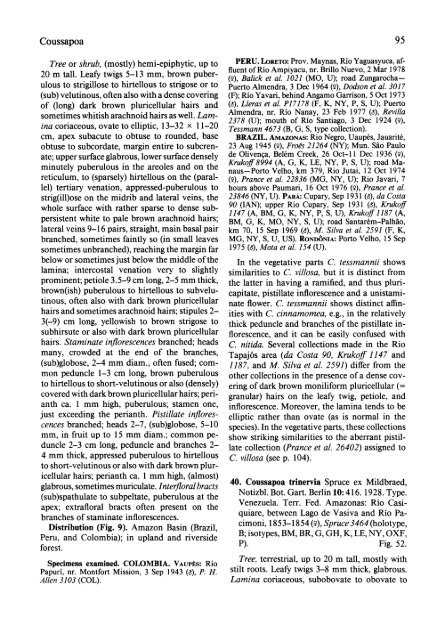Cecropiaceae: Coussapoa and Pourouma, with an ... - CNCFlora
Cecropiaceae: Coussapoa and Pourouma, with an ... - CNCFlora
Cecropiaceae: Coussapoa and Pourouma, with an ... - CNCFlora
You also want an ePaper? Increase the reach of your titles
YUMPU automatically turns print PDFs into web optimized ePapers that Google loves.
<strong>Coussapoa</strong><br />
Tree or shrub, (mostly) hemi-epiphytic, up to PERU. LORETO: Prov. Maynas, Rio Yaguasyuca, af-<br />
20 m tall. Leafy twigs 5-13 mm, brown<br />
fluent of Rio<br />
puber-<br />
Ampiyacu, nr. Brillo Nuevo, 2 Mar 1978<br />
(2), Balick et al. 1021 (MO, U); road Zungarochaulous<br />
to strigillose to hirtellous to strigose or to Puerto Almendra, 3 Dec 1964 (2), Dodson et al. 3017<br />
(sub) velutinous, often also <strong>with</strong> a dense covering (F); Rio Yavari, behind Angamo Garrison, 5 Oct 1973<br />
of (long) dark brown pluricellular hairs <strong><strong>an</strong>d</strong> (a), Lleras et al. P17178 (F, K, NY, P, S, U); Puerto<br />
sometimes whitish arachnoid hairs as well. Lam- Almendra, nr. Rio N<strong>an</strong>ay, 23 Feb 1977 (a), Revilla<br />
2378<br />
ina coriaceous, ovate to elliptic, 13-32 x 11-20<br />
(U); mouth of Rio S<strong>an</strong>tiago, 3 Dec 1924 (2),<br />
Tessm<strong>an</strong>n 4673 (B, G, S, type collection).<br />
cm, apex subacute to obtuse to rounded, base BRAZIL. AMAZONAS: Rio Negro, Uaup6s, Jauarite,<br />
obtuse to subcordate, margin entire to subcren- 23 Aug 1945 (9), Froes 21264 (NY); Mun. Sao Paulo<br />
ate; upper surface glabrous, lower surface densely<br />
de Olivenca, Belem Creek, 26 Oct-11 Dec 1936 (2),<br />
minutely puberulous in the areoles <strong><strong>an</strong>d</strong> on the Krukoff8994 (A, G, K, LE, NY, P, S, U); road M<strong>an</strong>aus-Porto<br />
Velho, km 379, Rio Jutai, 12 Oct 1974<br />
reticulum, to (sparsely) hirtellous on the (paral- (9), Pr<strong>an</strong>ce et al. 22836 (MG, NY, U); Rio Javari, 7<br />
lel) tertiary venation, appressed-puberulous to hours above Paumari, 16 Oct 1976 (2), Pr<strong>an</strong>ce et al.<br />
strig(ill)ose on the midrib <strong><strong>an</strong>d</strong> lateral veins, the 23846 (NY, U). PARA: Cupary, Sep 1931 (6), da Costa<br />
whole surface <strong>with</strong> rather sparse to dense sub- 90 (IAN); upper Rio Cupary, Sep 1931 (a), Krukoff<br />
1147<br />
persistent white to pale brown arachnoid<br />
(A, BM, G, K, NY, P, S, U), Krukoff 1187 (A,<br />
hairs; BM, G, K, MO, NY, S, U); road S<strong>an</strong>tarem-Palhao,<br />
lateral veins 9-16 pairs, straight, main basal pair km 70, 15 Sep 1969 (8), M. Silva et al. 2591 (F, K,<br />
br<strong>an</strong>ched, sometimes faintly so (in small leaves MG, NY, S, U, US). RONDONIA: Porto Velho, 15 Sep<br />
sometimes unbr<strong>an</strong>ched), reaching the margin far 1975 (a), Mota et al. 154 (U).<br />
below or sometimes just below the middle of the In the vegetative parts C. tessm<strong>an</strong>nii shows<br />
lamina; intercostal venation very to slightly similarities to C. villosa, but it is distinct from<br />
prominent; petiole 3.5-9 cm long, 2-5 mm thick, the latter in having a ramified, <strong><strong>an</strong>d</strong> thus pluribrown(ish)<br />
puberulous to hirtellous to subvelucapitate,<br />
pistillate inflorescence <strong><strong>an</strong>d</strong> a unistamitinous,<br />
often also <strong>with</strong> dark brown pluricellular nate flower. C. tessm<strong>an</strong>nii shows distinct affinhairs<br />
<strong><strong>an</strong>d</strong> sometimes arachnoid hairs; stipules 2- ities <strong>with</strong> C. cinnamomea, e.g., in the relatively<br />
3(-9) cm long, yellowish to brown strigose to thick peduncle <strong><strong>an</strong>d</strong> br<strong>an</strong>ches of the pistillate insubhirsute<br />
or also <strong>with</strong> dark brown pluricellular florescence, <strong><strong>an</strong>d</strong> it c<strong>an</strong> be easily confused <strong>with</strong><br />
hairs. Staminate inflorescences br<strong>an</strong>ched; heads C. nitida. Several collections made in the Rio<br />
m<strong>an</strong>y, crowded at the end of the br<strong>an</strong>ches, Tapajos area (da Costa 90, Krukoff 1147 <strong><strong>an</strong>d</strong><br />
(sub)globose, 2-4 mm diam., often fused; com- 1187, <strong><strong>an</strong>d</strong> M. Silva et al. 2591) differ from the<br />
mon peduncle 1-3 cm long, brown puberulous other collections in the presence of a dense covto<br />
hirtellous to short-velutinous or also (densely) ering of dark brown moniliform pluricellular (=<br />
covered <strong>with</strong> dark brown pluricellular hairs; peri- gr<strong>an</strong>ular) hairs on the leafy twig, petiole, <strong><strong>an</strong>d</strong><br />
<strong>an</strong>th ca. 1 mm high, puberulous; stamen one, inflorescence. Moreover, the lamina tends to be<br />
just exceeding the peri<strong>an</strong>th. Pistillate inflores- elliptic rather th<strong>an</strong> ovate (as is normal in the<br />
cences br<strong>an</strong>ched; heads 2-7, (sub)globose, 5-10<br />
species). In the vegetative parts, these collections<br />
mm, in fruit up to 15 mm diam.; common pe- show striking similarities to the aberr<strong>an</strong>t pistilduncle<br />
2-3 cm long, peduncle <strong><strong>an</strong>d</strong> br<strong>an</strong>ches 2- late collection (Pr<strong>an</strong>ce et al. 26402) assigned to<br />
4 mm thick, appressed puberulous to hirtellous C. villosa (see p. 104).<br />
to short-velutinous or also <strong>with</strong> dark brown pluricellular<br />
hairs; peri<strong>an</strong>th ca. 1 mm high, (almost)<br />
glabrous, sometimes muriculate.<br />
40.<br />
Interfloralbracts<br />
<strong>Coussapoa</strong> trinervia Spruce ex Mildbraed,<br />
(sub)spathulate to subpeltate, puberulous at the<br />
Notizbl. Bot. Gart. Berlin 10:416. 1928. Type.<br />
apex; extrafloral bracts often present on the<br />
Venezuela. Terr. Fed. Amazonas: Rio Casibr<strong>an</strong>ches<br />
of staminate inflorescences.<br />
quiare, between Lago de Vasiva <strong><strong>an</strong>d</strong> Rio Pa-<br />
Distribution (Fig. 9). Amazon Basin cimoni, 1853-1854<br />
(Brazil,<br />
(2), Spruce 3464 (holotype,<br />
Peru, <strong><strong>an</strong>d</strong> Colombia); in upl<strong><strong>an</strong>d</strong> <strong><strong>an</strong>d</strong> riverside B; isotypes, BM, BR, G, GH, K, LE, NY, OXF,<br />
forest.<br />
P). Fig. 52.<br />
Specimens examined. COLOMBIA. VAUPES: Rio<br />
Tree, terrestrial, up to 20 m tall, mostly <strong>with</strong><br />
Papuri, nr. Montfort Mission, 3 Sep 1943 (s), P. H. stilt roots. Leafy twigs 3-8 mm thick, glabrous.<br />
Allen 3103 (COL).<br />
Lamina coriaceous, subobovate to obovate to<br />
95
















